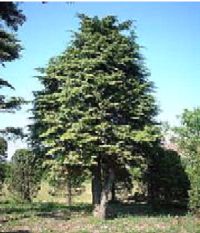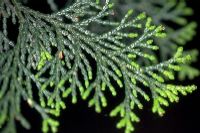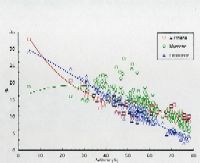Special Program for International Students
GRADUATE COURSE IN EARTH SCIENCE
& GEOENVIRONMENTAL SCIENCE
Current IDB students




Fabiola Ocampo Quintero (Colombia)
Email: fabiologa26 @yahoo.es
Thesis title: Elucidating the regulatory regions of the monoterpene synthase genes from Chamaecyparis obtusa.
Supervisor: Assoc Prof. Sadanobu Katoh (2007-2009).
Many conifer species respond to bark beetle attack and associated fungal infection by secreting oleoresin at the wound site, presenting toxicity against insects and fungi. This defensive secretion is a complex mixture of terpenoids (monoterpenes, sesquiterpenes and diterpenes) that are synthesized in the epithelial cells of specialized structures. Many monoterpene synthases catalyzes the formation of multiple terpenoids, and the regulatory genes have specifically diversified with speciation. Intraspecific variations of monoterpenes in conifers are known as “monoterpene chemotypes”, which provide different adaptivity to the environment. The variation in oleoresin monoterpenes can be seen as approaches to population resistance based on host disguise, alteration in the levels of pheromone precursors or predator attractants.
Individual variations in strains and the variation among clones in the monoterpene composition of hinoki (Chamaecyparis obtusa) were investigated. The analysis revealed the existence of four monoterpene chemotypes (5S, 37S, 55S and 70S). A similarity based cloning strategy yielded five new cDNAs clones from a needle cDNA library of hinoki monoterpene chemotypes that appeared to encode five distinct monoterpene synthases.
The purpose of the study is to investigate the regulatory regions of the cDNAs obtained from the four monoterpene chemotypes, to elucidate the molecular mechanism bearing the monoterpene diversity. To obtain the regulatory sequences, cloning of the corresponding genomic DNAs will be carried out as a first step, and the DNA-Walking strategy will be employed to clone the regulatory regions.
Spanish/Español:
Título de la tesis: Dilucidar las regiones reguladoras de los genes de la monoterpene sintasa de Chamaecyparis obtusa.
Muchas especies de coníferas responden al ataque del escarabajo de la corteza y a la infección del hongo asociado, secretando oleoresinas en el sitio de la herida, presentando toxicidad contra insectos y hongos. Esta defensiva secreción es una compleja mezcla de terpenoides (monoterpenos, sesquiterpenos y diterpenos), que se sintetizan en las células epiteliales de estructuras especializadas. Muchos monoterpenos sintasa cataliza la formación de varios terpenoides y los genes que los regulan se han diversificado específicamente con la especiación. Las variaciones intraespecificas de los monoterpenos en coníferas se conoce como “tipos químicos de monoterpenos”, los cuales proporcionan diferente adaptabilidad al medio ambiente. La variación en los monoterpenos de la oleorresina puede enfocarse a la población resistente, basándose en la simulación de hospederos, alteración de los niveles de precursores de las feromonas o atrayentes de predadores.
Se investigaron las variaciones individuales entre cepas y las variaciones entre los clones de hinoki (Chamaecyparis obtusa), en cuanto a la composición de los monoterpenos. El ensayo reveló la existencia de cuatro tipos químicos de monoterpenos (5S, 37S, 55S y 70S). Una estrategia similar basada en clonación, dio cinco nuevos clones de cDNAs de una librería de cDNA de tipos químicos de monoterpenos extraídos de agujas de hinoki, que aparecieron para codificar cinco diferentes monoterpenos sintasa.
La propuesta de estudio es investigar las regiones reguladoras de los cDNA obtenidos de los cuatro tipos químicos de monoterpenos, para dilucidar el mecanismo molecular de la diversidad de los monoterpene. Para obtener las secuencias reguladoras, se llevara a cabo la clonación del correspondiente DNA genómico como primer paso, y será empleada la técnica “DNA-Walking” para clonar las regiones reguladoras.
